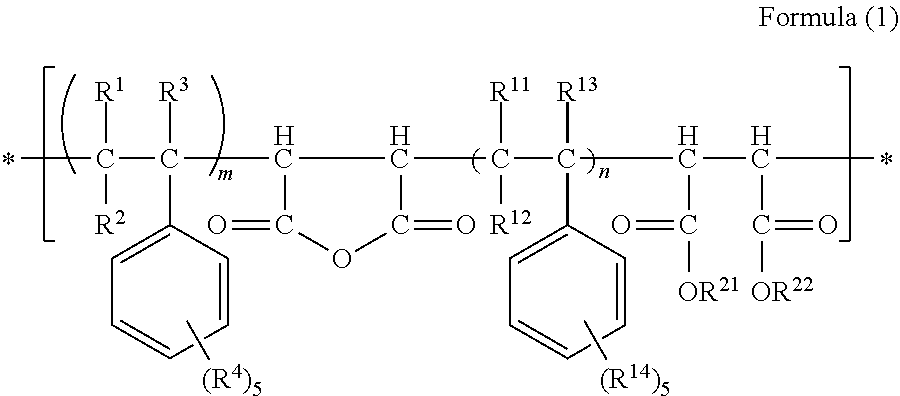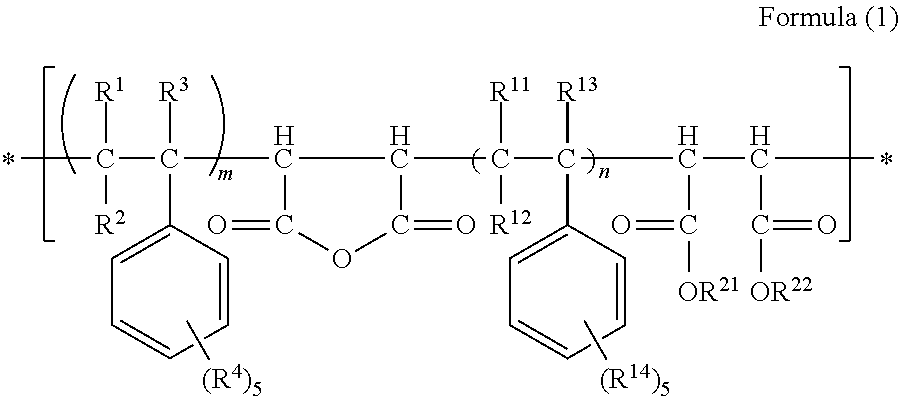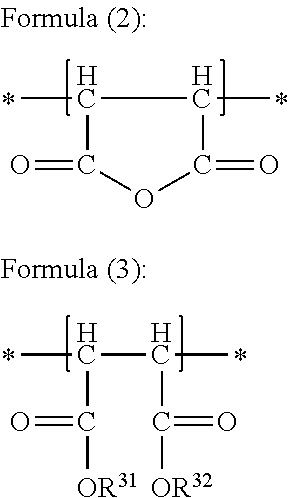Cellulose acylate film, method for producing same, polarizer and liquid crystal display device
a technology of cellulose acylate and polarizer, which is applied in the direction of manufacturing tools, impression caps, coatings, etc., can solve the problems of high retardation, styrenic additive to cellulose acylate film cannot readily improve the wet heat durability of the optical properties of the film, and the increase in the amount of additives to be added to the film rather lowers the wet heat durability of the film, so as to achieve low haze effect of the film
- Summary
- Abstract
- Description
- Claims
- Application Information
AI Technical Summary
Benefits of technology
Problems solved by technology
Method used
Image
Examples
example 1
Preparation of Solution Containing Partially Ring-Opened, Styrene / Maleic Anhydride Copolymer
[0209]A commercially-available styrene / maleic anhydride copolymer having a ratio of St / MAn shown in Table 3 below and having a degree of ring opening of 0% was dissolved in a mixed solvent of an alcohol mentioned below and methylene chloride to prepare a partially ring-opened, styrene / maleic anhydride copolymer. The detailed conditions are shown in the following Table. In every case, the amount of the solvent combined with the alcohol was 78 g.
[0210]A partially ring-opened, styrene / maleic anhydride copolymer having a degree of ring opening of 20% was prepared by dissolving 22 g of the styrene / maleic anhydride copolymer in Table 3, SMA1000P in the above-mentioned solvent combined with 0.7 g methanol, and then stirring it at 25° C. for 60 minutes, and thereafter this was static for 2 days.
[0211]A partially ring-opened, styrene / maleic anhydride copolymer having a degree of ring opening of 50% wa...
examples 2 to 23
, Comparative Examples 1 to 7
[0226]Cellulose acylate dopes were prepared in the same manner as in Example 1, for which, however, the degree of substitution of the cellulose acylate resin, the type and the amount of the compound having a negative birefringence, the kind of alcohol used for partial ring-opening reaction, and the type and the amount of the retardation enhancer were changed as in Table 5 below. The compounds having a positive birefringence, which are retardation enhancers, A, E and K were produced with materials shown in the above Table 1 and Table 2 by the method described in this description. The type and the amount of the compounds having a positive birefringence are also shown in the column of retardation enhancer in Table 5 below.
[0227]Next, like in Example 1, the dope was cast in a mode of solution casting and stretched, thereby producing cellulose acylate films of Examples 2 to 23 and Comparative Examples 1 to 7.
PUM
| Property | Measurement | Unit |
|---|---|---|
| Temperature | aaaaa | aaaaa |
| Fraction | aaaaa | aaaaa |
| Fraction | aaaaa | aaaaa |
Abstract
Description
Claims
Application Information
 Login to View More
Login to View More - R&D
- Intellectual Property
- Life Sciences
- Materials
- Tech Scout
- Unparalleled Data Quality
- Higher Quality Content
- 60% Fewer Hallucinations
Browse by: Latest US Patents, China's latest patents, Technical Efficacy Thesaurus, Application Domain, Technology Topic, Popular Technical Reports.
© 2025 PatSnap. All rights reserved.Legal|Privacy policy|Modern Slavery Act Transparency Statement|Sitemap|About US| Contact US: help@patsnap.com



